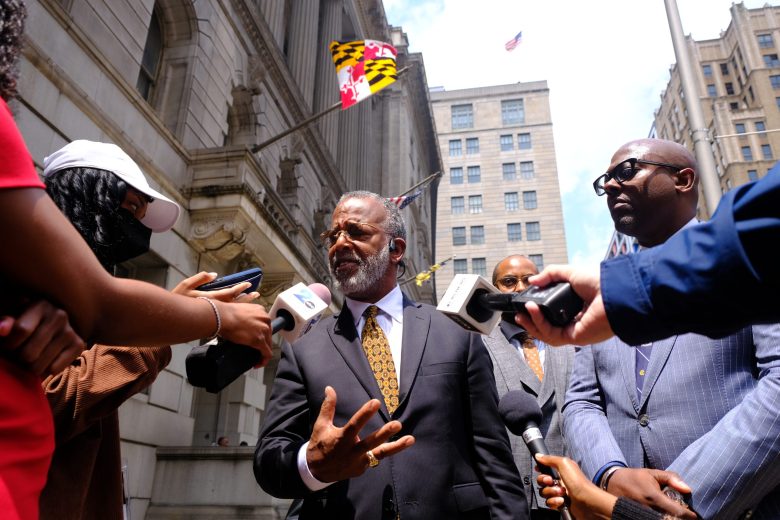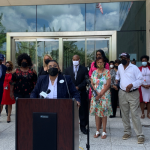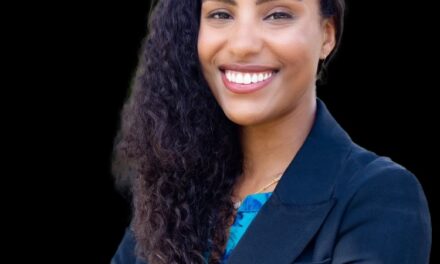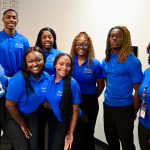By Tashi McQueen,
AFRO Political Writer,
tmcqueen@afro.com
The packed courtroom inside of the Clarence M. Mitchell Jr. Courthouse in Baltimore could only be likened to judgment day, as counsel on both sides delivered closing arguments on July 24.
Tavon Scott, a 16-year-old ex-squeegee worker, is on trial for the shooting and killing of Timothy Reynolds, 48, in July 2022. The incident occurred a day before Scott’s 15th birthday.
“They clearly got [the prosecutor’s] message today,” said Thiru Vignarajah, the Reynolds family attorney. “You’ve got to hope that the jury can put aside all of the tactics of distraction, theater, inflaming of the jury and insulting the victim.”
On July 24 the day started at approximately 9:45 a.m., with people crowded outside of the courtroom waiting to enter.
So many people were in attendance on the fifth day of trial that the front rows, which have been exempt from use since the start of the trial, were permitted for use and members of Scott’s family had to take turns sitting in the courtroom.
“I feel like my client will be exonerated of these charges,” said J. Wyndal Gordon, Scott’s attorney.
Beyond a reasonable doubt
During his argument, Gordon honed in on the “beyond a reasonable doubt” aspect of the case.
According to Cornell Law School, beyond a reasonable doubt is what’s legally required to confirm a conviction in a criminal case. The prosecution has the burden of proving that the defendant is guilty and that no lingering doubts remain from the evidence presented.
Gordon claims the prosecution did not present enough evidence, and jurors may be left with more questions than they had coming into the case.
“They are not telling the whole story,” said Gordon. “We need to consider the additional witnesses who were not heard.”
There were nine eye-witnesses for the prosecution and only two of them testified.
A UPS driver, who was driving down Light and Conway St. at the time of the incident, and the person whose dashcam was used during the trial were called to the stand on July 20.
“What are they trying to hide?” said Gordon. “It needs to be considered that witnesses did not provide straightforward answers to the defendant’s questions.”
Self-Defense and Scott’s age
Gordon continued his claim that the shooter acted in self-defense.
“Imagine a 6-foot-3, 329-pound going after a 120-pound 5-foot-5 child who’s 14 years old. Imagine the fright, the adrenaline, emotions, and everything else that would come into play. When you face this kind of danger that is of a deadly nature,” said Gordon. “Forget that the child had a gun.”
Gordon demonstrated the use of the bat by swinging an umbrella during the trial in the direction of jurors.
“It was raining this morning. It was a perfect opportunity to bring an umbrella into the courtroom and use it as a prop, so the jury can see how frightening it is,” said Gordon.
The prosecutor defended the decision not to bring in the bat as evidence by calling the instrument a biohazard.
Defense attorney Warren Brown disagreed with the reasoning.
“I think it would have hurt the state’s case for the jury to see this bat and that’s why they didn’t bring it in. They mentioned something about some , but they had gloves for everything else,” said Warren Brown, Scott’s other defense attorney.
The defendant’s age came up multiple times throughout the trial and on the day of closing arguments. Banks stated that age should not excuse Scott from murder charges.
“At 14 years old, he is old enough to know right from wrong—old enough to conceal his identity,” said Banks.
Banks pointed out several times that Reynolds, though he did swing the bat at the squeegee kids with about three to five feet between him and the teens, he did not hit anyone.
“Mr. Reynolds was dazed as he was hit upside the head. The boys were scattered. The defendant was 8 to 10 feet away from Mr. Reynolds. Did he have to shoot? No, he did not,” said Banks.
“There was time for Scott to retreat. He should have retreated,” said Banks. “There was no harm being done.”
Judge Jennifer Schiffer decided to define “retreating” as a person who did everything to escape. In this case, the shooter did not appear to do everything to escape.
In response to the defendant’s attorney’s pressure to not investigate Reynolds more, the prosecutor said, “Mr. Reynolds is not on trial. It’s Tavon Scott.”
The court had to break at least two times during Gordon’s closing arguments due to issues he had with objections. He was particularly butting heads with the judge.
One resident commented on the case.
“I hate to say that they’re going to find the young brother guilty,” said Michael Teal, 61, a West Baltimore resident. “Granted, the young man shouldn’t have had a gun, but what was he supposed to do with a man swinging a bat at him?”
Monday’s closing arguments were preceded by a week of arguments from the prosecution, who began presenting their case on July 18, one day after jury selection.
“It’s a Baltimore tragedy. There are no winners here,” Thiru Vignarajah, the spokesperson for the Reynolds family, told the AFRO. “The Reynolds family has been immensely thoughtful. They feel for the defendant’s family, they have children too.”
Each day inside of the marble-lined Clarence M. Mitchell Jr. Courthouse, members of the press, law enforcement officers and family members of both the defendant and victim listened each day as the sound of shackles rippled through the deafening silence, announcing the arrival of the teen defendant. Both sides have had tears in their eyes and tear-soaked tissues in their hands.
At 16, Scott has arrived each day with a loosely tamed beard and sullen eyes. Last July he was a squeegee worker at the intersection of Light and Conway St. Now he’s a defendant sitting in a courtroom on trial for the murder of Reynolds.
On the day in question, squeegee workers did not touch Reynolds’ vehicle and it is not evident why he got out of the car. Several witnesses confirmed there were no water streaks on the car – a sign of squeegee work- or any sign of damage. Prior to the fatal altercation, Reynolds had negative interactions with squeegee kids, according to comments he made publicly on Twitter. Scott’s attorneys say that Baltimore Police Department (BPD) officials have not investigated why Reynolds got out of the car.
Reynolds’ negative comments about squeegee workers were not addressed or submitted as evidence by the prosecution. The defendant’s lawyers did not admit the tweets as evidence.
Crucial pieces of evidence admitted
Prosecutor and Assistant State’s Attorney Cynthia Banks presented vital evidence to the jury last week, including dash cam and closed-circuit television (CCTV) video showing the killing of Reynolds and events leading up to the incident.
Alongside witness testimonies, she focused on the contents of a black bag held by the shooter.
Contents included a handgun with a blue bandana wrapped around the handle. The footage includes images of the shooter in a pink shirt and black pants. The prosecution has shown evidence that Scott’s DNA was found on the straps of the black bag.
“Critical facts are being presented to the jury,” said Vignarajah. “All we can hope for is a measure of justice based on the real facts.”
Michael Curtin, the secondary homicide detective on the case, testified that he made a flier with photos from CCTV footage of the Light and Conway St. area to see if anyone within BPD could identify the shooter.
Kevin Rivera, a Baltimore Police officer, testified that he was shown the photograph and said he recognized the shooter. Rivera pointed to Scott when asked if the shooter was in the courtroom. The prosecutor showed bodycam footage and stills to the jury of Rivera’s interaction with Scott and another squeegee worker days before the shooting.
Rivera was the only one that could identify Scott as the shooter.
Dr. Pamela Ferreira detailed autopsy reports of Reynold’s body. A post-mortem examination report by the Office of the Chief Medical Examiner State of Maryland reveals that Reynolds died as a result of five multiple gunshot wounds: three bullets that entered Reynold’s back, one entered on his side and another entered through the left side of his mouth.
The defendants’ rebuttals
During the trial last week, Gordon zeroed in on what he called incompetence on the part of Curtin, citing that he had only been assigned to cover homicides in Baltimore City for two months before being put on the high-profile case.
The black bag held a variety of gift cards to local eateries and one credit card owned by a man named Robert Downs. The police department checked three viable addresses for Downs, whose name was directly associated with the bag, but could not locate him.
Gordon says police didn’t do enough during their search.
“They never made any real effort to find [Downs]. They didn’t charge him with the handgun found in his across-the-chest bag. They didn’t charge him with murder,” said Gordon during an impromptu press conference during lunch recess on July 19. “Everything points to [him], so it’s interesting to see how they just focused on one thing and failed to consider all the other information they received.”
The black bag was also determined to be a “community bag” for all squeegee boys by the primary detective of the case, John Amato. Amato does not believe that the bag or the bandana belongs to Scott.
Vignarajah called Gordon’s claims of “road rage” by Reynold shown by crossing eight lanes of traffic, wielding a bat, to confront the squeegee boys “lazy.”
“This is a lazy line of cross-examination. It’s trial advocacy 101,” said Vignarajah. “It rarely works on the jury.”
The defendant’s side also tried to make a case about Reynolds being drunk during the incident. An admitted toxicology report countered his argument. According to the People’s Law Library of Maryland, a person with a blood alcohol concentration level of .08 or more is deemed under the influence. The report showed that Reynold’s blood alcohol level was just .03.
The room was tense as the judge massaged her temples and grew frustrated with the defense attorney’s intimidating demeanor towards the witnesses. She even told him to “cut it out” when he began antagonizing an expert DNA analyst on the definition of inferred genotypes.
Missing information
Based on testimony from Sean Dorr, a forensics unit examiner, and the defendants’ questioning, BPD did not thoroughly investigate four other individuals identified at the crime scene.
“BPD was very sloppy with their investigation,” said Gordon.
Day four brought forth the fingerprints of four more individuals through water and Gatorade bottles found at the scene of the crime.
Amato said that two out of the four individuals were not able to be sufficiently identified, no incriminating evidence was found on the third person and Robert Downs was the fourth one identified. Downs’ investigation was incomplete.
Scott’s prints were not found on the bottles.
Tashi McQueen is a Report For America Corps Member.
The post Jury deliberations for accused former squeegee worker begin in Baltimore appeared first on AFRO American Newspapers .











